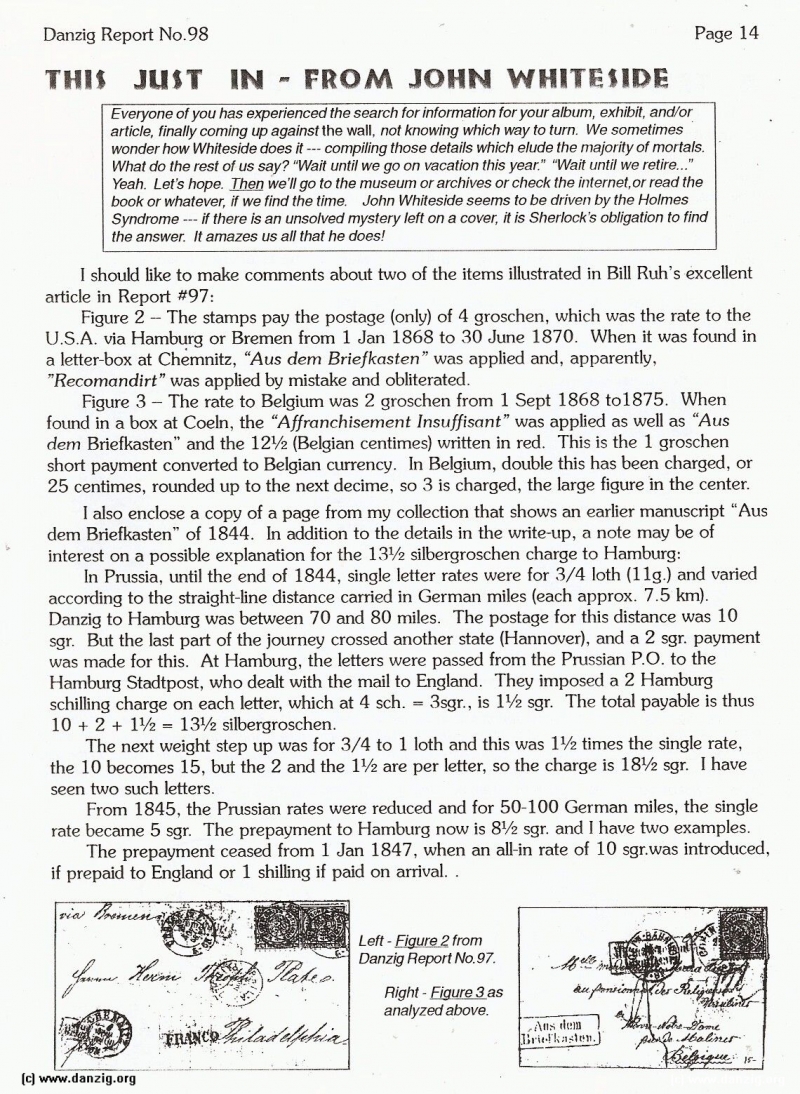
THIS JUST IN - FROM JOHN WHITSIDE
Everyone of you has experienced the search for information for yo ur album, exhibit, and/or article, finally coming up agaInst the wall, not knowing which way to turn. We sometimes wonder how Whiteside does it --- compiling those details which elude the majority of mortals. What do the rest of us say? “Wait until we go on vacation this year.” “Wait until we retire...” Yeah. Let’s hope. .Thíi we’ll go to the museum or archives or check the Internet, or read the book or whatever, if we find the time. John Whiteside seems to be driven by the Holmes Syndrome --- if there is an unsolved mystery left on a cover, it is Sherlock’s obligation to find the answer. It amazes us all that he does!
I should like to make comments about two of the items illustrated in Bill Ruh’s excellent article in Report #97:
Figure 2 — The stamps pay the postage (only) of 4 groschen, which was the rate to the U.S.A. via Hamburg or Bremen from 1 Jan 1868 to 30 June 1870. When it was found in a letter-box at Chemnitz, “Aus dem Brief kasten” was applied and, apparently, “Recomandirt” was applied by mistake and obliterated.
Figure 3 — The rate to Belgium was 2 groschen from 1 Sept 1868 to1875. When found in a box at Coeln, the “Affranchisement Insuffisant” was applied as well as “Ausdem Briefkasten” and the 121/2 (Belgian centimes) written in red, This is the 1 groschen short payment converted to Belgian currency. In Belgium, double this has been charged, or 25 centimes, rounded up to the next decime, so 3 is charged, the large figure in the center.
I also enclose a copy of a page from my collection that shows an earlier manuscript “Ausdem Briefkasten” of 1844. In addition to the details in the write-up, a note may be of interest on a possible explanation for the 13½ silbergroschen charge to Hamburg:
In Prussia, until the end of 1844, single letter rates were for 3/4 loth (11g.) and varied according to the straight-line distance carried in German miles (each approx. 7.5 km). Danzig to Hamburg was between 70 and 80 miles. The postage for this distance was 10sgr. But the last part of the journey crossed another state (Hannover), and a 2 sgr. payment was made for this. At Hamburg, the letters were passed from the Prussian P.O. to the Hamburg Stadtpost, who dealt with the mail to England. They imposed a 2 Hamburg schilling charge on each letter, which at 4 sch. = 3sgr., IS 11/2 sgr. The total payable is thus 10 + 2 + 1½ = 13 1/2 silbergroschen.
The next weight step up was for 3/4 to 1 loth and this was 1½ times the single rate, the 10 becomes 15, but the 2 and the 1½ are per letter, so the charge is 18½ sgr. I have seen two such letters.
From 1845, the Prussian rates were reduced and for 50-100 German miles, the single rate became 5 sgr. The prepayment to Hamburg now is 8½ sgr. and I have two examples.
The prepayment ceased from 1 Jan 1847, when an all-in rate of 10 sgr.was introduced, if prepaid to England or 1 shilling if paid on arrival..
Danzig Report Vol. 1 - Nr. 98 - January - February - March - 1998, Page 14.
Hits: 3288
Added: 20/05/2015
Copyright: 2025 Danzig.org

